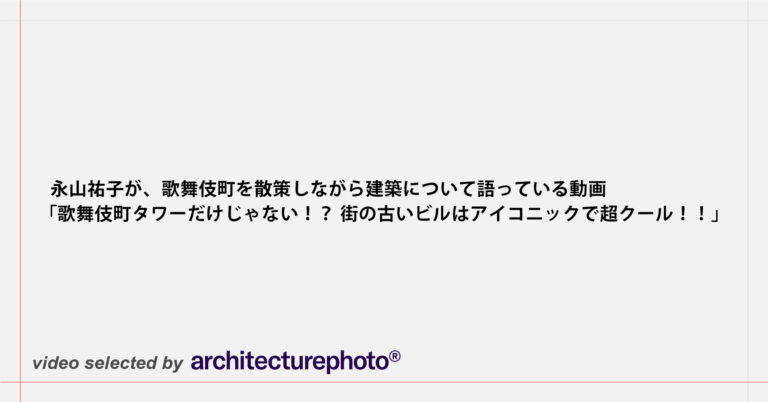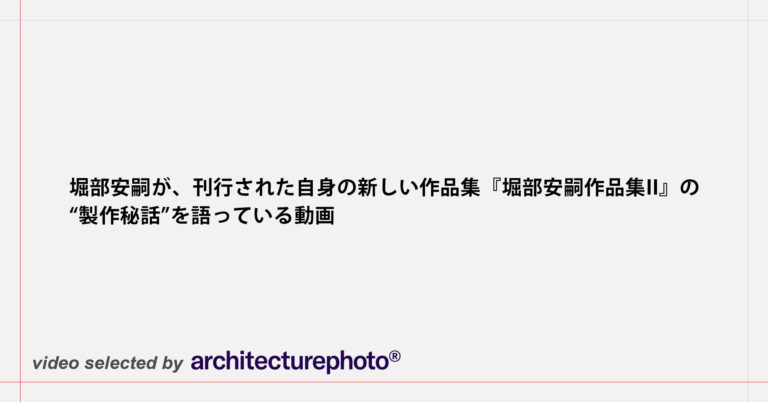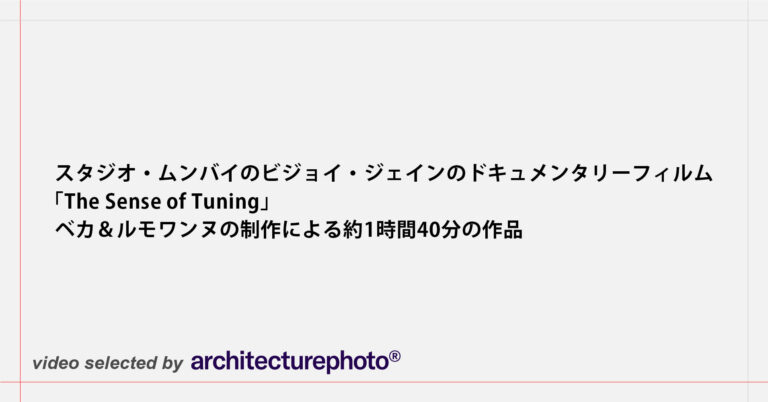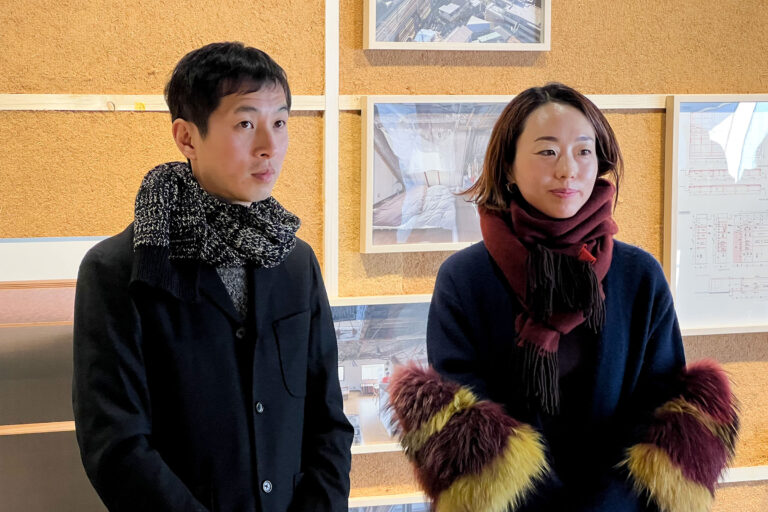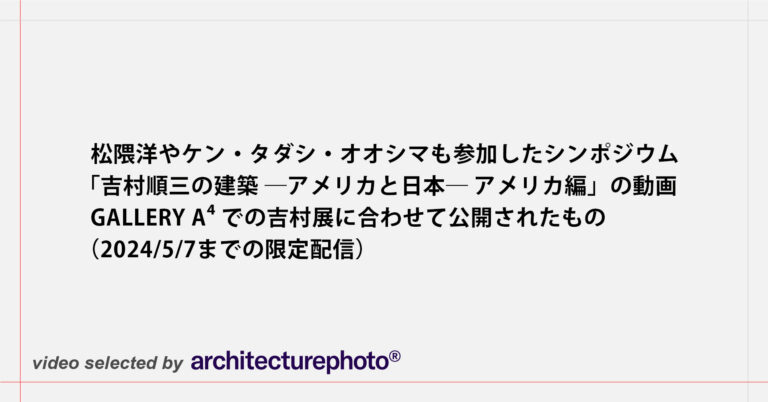益子義弘・林寛治・藤井章・大澤悟郎・松隈洋による、吉村順三についてのシンポジウム「吉村順三の建築 ―アメリカと日本― 日本編」の動画。元所員や研究者が登壇して、2024年2月に行われたものです。ギャラリーエークワッドでの展示に合わせて行われました。2024年5月7日18:00までの限定公開とのこと。
video archive
青木淳による講演「京都市美術館の90年」の動画です。同館の館長として2023年11月の京都市美術館90周年記念祭で行ったものです。※youtube公式の埋込機能を使って紹介しています
永山祐子が、歌舞伎町を散策しながら建築について語っている動画「歌舞伎町タワーだけじゃない!? 街の古いビルはアイコニックで超クール!!建築家の永山祐子さんと歌舞伎町を散歩してみた」です。youtubeチャンネル「ブラカブキ-歌舞伎町探索-」が公開したものです。前編の歌舞伎町タワーを訪問している動画はこちら。
歌舞伎町に精通した人物と歌舞伎町を散歩しながら、定番スポットからマメ知識まで色々知れちゃうお散歩番組!
ツアー企画第四回目は、【歌舞伎町 建築ツアー】
東急歌舞伎町タワーの外装デザインを手掛けた永山祐子さんを案内人にお招きし、手塚マキとシャララジマさんが歌舞伎町の建築物を見ながらブラ歌舞伎!
ツアー後半は、いよいよ街歩き!普段通る何気ない道に隠された意外な発見と建築家ならではの視点に手塚マキ、シャラちゃんが質問しまくります!
鈴木理考建築都市事務所+座二郎+高橋みのり による、東京・杉並区の「オープンスカイハウス」での生活を紹介する動画です。屋根のないリビングのある住宅としても注目を集めた2019年竣工の作品です。「Never Too Small」というyoutubeチャンネルが制作して公開したものです。※youtube公式の埋込機能を使って紹介しています。
本作品は、アーキテクチャーフォトでも特集記事として紹介しています。
安藤忠雄が出演している動画「停滞するニッポンの今と未来を語る」です。テレビ番組「賢者の選択」の為に収録され2024年2月に公開されたもの。※youtube公式の埋込機能を使用して紹介しています
建築家・安藤忠雄氏が発案・設計・寄贈し2020年7月にオープンした「こども本の森 中之島」。1万8000冊の蔵書に加えて、沢山の仕掛けや、何もない薄暗い空間など、安藤建築ならではの遊び心ある空間が、子供たちの想像力を掻き立てる。この場所で「パブリックの感覚と目標を持った子供をつくらねば」と語る安藤氏のニッポンの未来や、こどもに込めた想いとは。そして安藤氏にとって「建築」とは?
ケン・タダシ・オオシマによる、ライトについての講演の動画です。パナソニック汐留美術館での「フランク・ロイド・ライト 世界を結ぶ建築」展に合わせて2024年2月に公開されたものです。2024年2月26日までの期間限定公開です。
フランク・ロイド・ライトはグローバル・アーキテクトの先駆です。「開館20周年記念展/帝国ホテル二代目本館100周年 フランク・ロイド・ライト 世界を結ぶ建築」では、ライトの初期の集大成である「帝国ホテル」を起点としながら、さらにその後拡張していく彼のデザイン思想をたどります。近年の学術調査の成果を踏まえ、本展の監修者が展覧会の見どころを解説いたします。言語は英語、逐次通訳つき。
講師 ケン・タダシ・オオシマ氏(本展企画監修者、ワシントン大学建築学部教授)
講義分数 約90分
動画公開日時 2月19日(月)午前10時〜2月26日(月)午前10時まで
堀部安嗣が、自身の新しい作品集『堀部安嗣作品集II』を解説している動画です。こちらの書籍はamazonで予約受付中です(2024年2月26日発売)。
2024年2月26日に堀部安嗣の作品集Vol.2が発売となります。
堀部が完成したばかりの作品集を手に、見どころを語りました。こだわりのつまった素敵な作品集になりました。
書店などで見かけた際はぜひお手にとって頂けますと幸いです。
香山壽夫による講演「建築は、大樹のように、時と共に育つ」の動画です。2023年4月に建築家会館で行われたものです。
2023年4月25日に東京・神宮前の建築家会館JIA館建築家クラブにて行われた、市民・建築NET発足会での香山壽夫(東京大学名誉教授)の講演「建築は、大樹のように、時と共に育つ」です。
※字幕はYouTubeの自動字幕機能を利用しておりますので、正しく変換されていない部分は随時修正していきます。ご了承のほどよろしくお願いいたします。
スタジオ・ムンバイのビジョイ・ジェインのドキュメンタリーフィルム「The Sense of Tuning」です。ベカ&ルモワンヌの制作による約1時間40分の映像作品です。
(翻訳)
「The Sense of Tuning」は、スタジオ・ムンバイの建築家ビジョイ・ジェインのポートレートであり、その場で描かれたスケッチを思わせ、動きとその瞬間の活気を捉えています。
この映画は、この人物と彼の作品を誇張して賞賛するポートレートではなく、建築家の感受性という壊れやすく貴重な素材を珍しい自発性で探求し、彼の空間の知覚がどのように育くまれているかに光を当てています。
パフォーマティヴな映画体験として構想されたこの映画は、ジャインとベカ&ルモワンの1日にわたる出会いの錬金術を捉えています。それは、ムンバイのストリートの生命エネルギーに私たちを引き込む、強烈な放浪の12時間です。スタジオでのプライベートな時間の中で作成されたビジュアルノート、非公式な都市の戦術の観察、制作現場への訪問からなるこのフィルムは、ジェインの作品がいかにムンバイの街と密接に結びついているかということを明らかにし、限りないリソースとインスピレーションを与えてくれます。この感覚的なフィルムでは、ジェスチャーが直感の言語なのです。(原文)
“The Sense of Tuning” is a portrait of the architect Bijoy Jain of Studio Mumbai, evoking a sketch made on the fly, captured in the vibrancy of movement and of the moment.
Nothing of a hagiographic portrait rigidly depicting this figure and his work, the film explores the fragile, precious material of the architect’s sensibility with rare spontaneity, shedding light on how his perception of the emotion of space is nurtured.
Conceived as a performative cinematic experience, this film captures the alchemy of a day-long encounter between Jain and Beka & Lemoine – twelve hours of intense wandering, plunging us into the vital energy of the streets of Mumbai. Comprising visual notes made in the privacy of the studio, observations of informal tactics of the city and visits to production sites, the film reveals how closely Jain’s work is tied to the city of Mumbai, providing endless resources and inspiration. In this sensory film, gestures are the language of intuition.
能作文徳と常山未央が、自身のTOTOギャラリー・間での展覧会「都市菌 — 複数種の網目としての建築」を解説している動画です。アーキテクチャーフォトでは、この展覧会を特集記事として詳細に紹介しています。
以下は、公式の展覧会概要です。
TOTOギャラリー・間では、「能作文徳+常山未央展:都市菌(としきのこ)― 複数種の網目としての建築」を開催します。
能作、常山両氏は、建築設計や論考執筆に加え、国内外の大学を拠点に、建築と都市と生態系の関係性リサーチを続けてきました。自宅兼事務所の「西大井のあな」では、鉄骨造の中古住宅に光と熱が循環する孔を開け、コンクリートで覆われた外構を自分達の手ではつり、土中改善を行うなど、エコロジカルな視点で改修しています。そこは他で得た学びを実験し、次のプロジェクトへと展開させる実践の場となっています。彼らが「URBAN WILD ECOLOGY」と呼ぶ、こうした都市の中に野生を取り戻す取り組みに加え、近年では石場建てや木組などの伝統知、藁や土壁といった土に還る素材を積極的に設計に取り入れています。
彼らは都市を、「人間の手が入った多様な生物が暮らす居住域」だと言います。課題を抱える現代の都市の一部を分解し、その養分を吸収し、菌(きのこ)のように成長する。そんな腐敗と再生の網目の結節点として建築を捉え、野生や伝統知を手に、網目に切り込みを入れつなぎ直すことにより、複数種のネットワークを構築しようとしています。
本展は、「西大井のあな」のさらなる改修案や、最新作「秋谷の木組(秋谷スマートハウス E棟)」をはじめとするプロジェクトの断面図や模型などを通じて、網目をつなぎ直すために誰もが真似できる小さな試行錯誤を共有する試みです。その先に、人新世と呼ばれる時代における建築の可能性やビジョンを感じ取っていただければ幸いです。
ケン・タダシ・オオシマ、田中厚子、シャーロット・レーモンド、ウィリアム・ウィテカー、松隈洋が参加したシンポジウム「吉村順三の建築 ―アメリカと日本― アメリカ編」の動画です。GALLERY A⁴ での吉村展に合わせて公開されたもの。2024年5月7日までの限定配信となっています。
建築家・吉村順三の眼(まなざし) ーアメリカと日本ー
シンポジウム「吉村順三の建築 ―アメリカと日本― アメリカ編」(期間限定配信)講師:ケン・タダシ・オオシマ(ワシントン大学教授)
田中厚子(建築史家)
シャーロット・レーモンド(写真家、レーモンド・ファーム・センター 共同ディレクター)
ウィリアム・ウィテカー(ペンシルベニア大学建築アーカイブ キュレーター)
松隈洋(神奈川大学教授、京都工芸繊維大学名誉教授)
進行:岡部三知代(ギャラリーエークワッド館長、主任学芸員)
配信期間:2024年2月2日(金)~5月7日(火)18:00まで
レム・コールハース、イルマ・ボーム、ハンス・ウルリッヒ・オブリストによる鼎談「デジタル時代の緊急図書 – なぜ触感はかけがえのないものなのか?(Urgent Books in the Digital Age – Why the Tactile Experience Is Irreplaceable)」の動画です。DLDというイベントの一環としてドイツ・ミュンヘンで2024年1月に行われたものです。イベントの公式ページはこちら。
宮崎浩 / プランツアソシエイツによる講演の動画です。日本建設業連合会の主催で2023年10月に行われたもの。
一般社団法人日本建設業連合会は、建築本部の事業活動の基本方針の一つに「世界に誇れる未来の建築文化の創造」を掲げ、建築を担う次世代に向けての情報発信を目的として、建築セミナーを毎年開催しています。
2023年度は、プランツアソシエイツの宮崎浩氏を講師にお迎えして、-あらためて「ものづくりの現場」から-をテーマに講演していただきました。
また、第2部では、宮崎浩氏と日建連で建築設計委員長を務める賀持剛一氏との対談を実施いたしました。
第二部の対談の動画は以下に掲載します。




